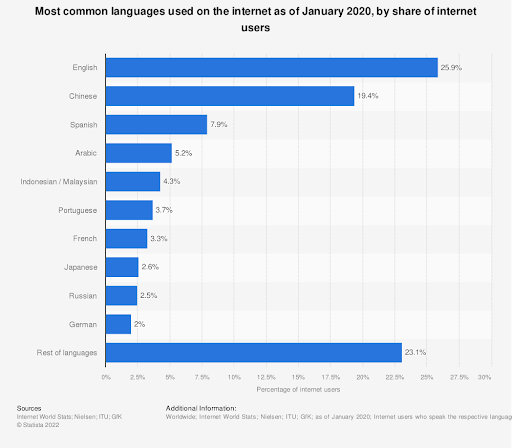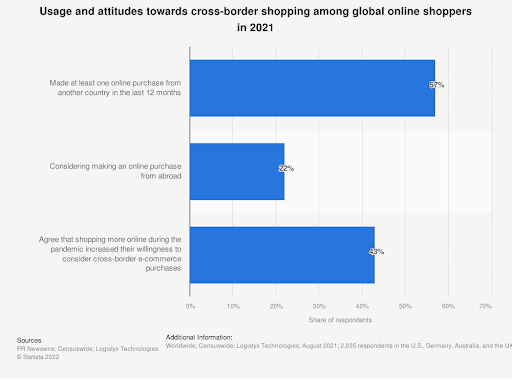A 5-Step Checklist For Successful Website Localization

Although it’s less frequently discussed than other big hitters like design and promotion, language is a major factor in fulfilling your website’s potential for optimal customer engagement.
When surveyed, 76% of global consumers expressed a preference for purchasing products with information in their own language. The same survey identified that the majority of customers want to be able to read reviews, make payments and decisions in a language they understand.
While this might seem like common sense, entrepreneurs and business owners often underestimate the value of foreign markets. According to a 2021 report, there is a far larger e-commerce market in non-English speaking countries.
What is Website Localization and Why Do You Need It?
Website localization is the process of translating an existing site into the local language and cultural context of a target market.
The localization process goes beyond simply putting your website through Google Translate. The process is about reaching new linguistic markets in a valuable and meaningful way. By targeting a few relevant areas you can vastly improve the user experience and engagement on your site.
When a potential customer uses a search engine to find products and information, the SERP (Search Engine Results Page) uses sites’ metadata to match users' searches with relevant content. This means that search engines are looking at your metadata to determine things like the language and region of your page before deciding on how high to place you in a user’s search results.
SEO (Search Engine Optimization) can improve your position in certain search results by including certain keywords on your website. If your pages are localized with relevant keywords, this will also help to make your site more visible, helping to drive up traffic.
With that in mind, here are seven things to consider when building a website localization strategy for your organization.

Step 1: Assemble your localization plan
When you’re starting out, remember that there are likely legal and logistical elements of catering to your new audience to consider. Different countries will impose various regulations on data capture and site security. If you supply a physical product, how will it get to your customers? You'll need to consider how your service meets international shipping regulations and new supply demands.
Additionally, after your international customers find your site in their language, they are going to expect that your team is going to be capable of answering any questions they have. There are a handful of different strategies to employ - for example, you might use a virtual waiting room tool to deal with incoming questions or outsource your call center to local service providers. Another option is to provide meeting room technology to answer common questions and upload them as videos in different languages.
Step 2: Identify your market
Simply put, the first step is to understand the culture and buying behaviors of your target markets. It’s important to keep in mind that different cultures interpret visual and language cues in different ways than what might be common to your current audience.
Your research might include questions such as:
• What are their payment preferences?
• Are there regional differences in language and culture?
• Are there differences in what products are popular? Is there already a growing market for this product?
• Can these buyers afford the product?
It's important to answer these questions and many more before you start investing in a dedicated localization strategy. While carrying out your research, keep in mind the potential ROI of the strategy - you'll want to ensure that this new locale will generate enough revenue to make it worth your while.
Step 3: Your localization team
You need to dedicate time and potentially even team members to achieve your goal. Rather than working in a silo, it's better if your team is working in an integrated way. It might be worth involving your team in the process of conducting the necessary market research into your target audience while you are still in early stages.
Otherwise, it's important to figure out who will be involved in the localization process at your organization. While keeping the entire process in-house is possible, it's often prohibitively expensive and can be more time-consuming. Finding a vendor that can act as an extension of your team and build out process, find the right translators, and help scale your program can be the better longterm option in terms of cost, scalability, and effectiveness.
Step 4: Readying your product, content, and website for localization
One of the most (if not the most) important steps in the process is actually readying your work and building a good infrastructure for localization. That really means making sure your products, content, and website are all built out with localization in mind.
Content that is created for localization keeps things concise, reduces the use of idiomatic phrases, tries to stick to present tense, and more. While these steps may not seem important, they do make the translation process much smoother from language to language.
On the other hand, a product that's built for localization has flexible code, leaves room for regional formatting (like dates, times, measurements, and currencies), uses neutral colors and images, and more.
Step 5: Test, measure, and refine your localization workflows
Though you've started the localization process and content is coming back translated and ready for new markets, the process is far from over. Any changes or new content pieces need to be reconsidered and continuously localized to ensure they're kept up to date and relevant at all times.
One important piece of that equation is testing. If you've localized your products and content into Chinese for example, do the right measurements and currencies appear? Are users able to find what they expect? This step is crucial in order to make sure your results are actually accurate. Testing as a service measures the quality of the localized site you have produced. It is important to make sure it is capable of meeting the demands of your target audience.
When it comes to measuring the success of localization, there are several metrics to consider:
• Sales in your target location
• SEO ranking
• Marketshare
• Pageviews and conversion in a given language
• The overall cost of translation and localization maintenance
By measuring these key areas, you can see how well your site is performing in your new market.
While localization can be a huge undertaking, don't forget the benefits: accessing a new market, driving more traffic and increasing your reach. When done right, it can be a huge boost to your bottom line!
• • •
 Jenna Bunnell is the Senior Manager for Content Marketing at Dialpad, an AI-incorporated cloud-hosted unified communications system that provides valuable call details for business owners and sales representatives. She is driven and passionate about communicating a brand’s design sensibility and visualizing how content can be presented in creative and comprehensive ways. Check out her LinkedIn profile. Jenna has also written to domains such as Freelance Writing Jobs and CorporateVision.
Jenna Bunnell is the Senior Manager for Content Marketing at Dialpad, an AI-incorporated cloud-hosted unified communications system that provides valuable call details for business owners and sales representatives. She is driven and passionate about communicating a brand’s design sensibility and visualizing how content can be presented in creative and comprehensive ways. Check out her LinkedIn profile. Jenna has also written to domains such as Freelance Writing Jobs and CorporateVision.



